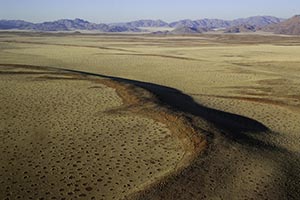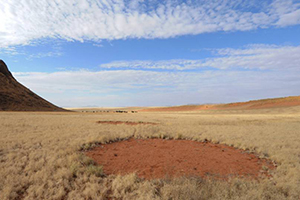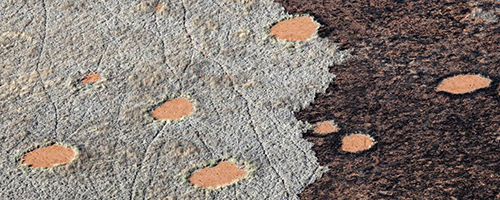Fairy Circles, Explained?
9/1/2016
 Scientists may be closer to solving the mystery of Namibia's "fairy circles" thought to be endemic to a remote swath of the Kalahari Desert. The enigmatic circles of sand — burnt orange, almost impeccably round and rimmed by a fringe of tall grass — are spaced at surprisingly regular intervals across the otherwise barren landscape. Over the course of decades, they appear, expand and then fade, almost as if they had a life cycle of their own. And, viewed from above, they seem so perfect and improbable their existence can only be ascribed to something not of this world, reports the Washington Post. Whatever their cause, the fairy circles have brought countless scientists, mystics and conspiracy theorists to the Kalahari as that was long thought to be the only place they could be explored.
Scientists may be closer to solving the mystery of Namibia's "fairy circles" thought to be endemic to a remote swath of the Kalahari Desert. The enigmatic circles of sand — burnt orange, almost impeccably round and rimmed by a fringe of tall grass — are spaced at surprisingly regular intervals across the otherwise barren landscape. Over the course of decades, they appear, expand and then fade, almost as if they had a life cycle of their own. And, viewed from above, they seem so perfect and improbable their existence can only be ascribed to something not of this world, reports the Washington Post. Whatever their cause, the fairy circles have brought countless scientists, mystics and conspiracy theorists to the Kalahari as that was long thought to be the only place they could be explored.
Recently it was discovered that similar circles exist in the Pilbara, a dry, thinly populated region of western Australia. Residents had mused about their own fairy circles for years, but no one had the resources or the expertise to investigate them more thoroughly. When international scientists recently visited the site, it appeared that the circle's pattern supported the theory of "self-organization" when an unstructured and chaotic group transforms into an organized system without any kind of central coordination.
 In the Pilbara, after a rainfall, the scant water is pulled in all directions by the desert's thirsty plants. Depending on how those plants are distributed, some spots inevitably become drier than others. Nothing grows there, so the clay becomes hard and impermeable. And the next time rain falls, it skims over the surface of the crusty clay until it reaches an area where plants are growing. Those plants absorb the water and then put down bigger roots, so that when the next rain comes they're able to pull it away from their neighbors — killing them off and making the bare spot even larger. In Namibia, the circles form slightly differently: Instead of washing into the waiting roots of nearby plants, water sinks into the porous desert sand, turning the bare fairy circles into a reservoir for a circle of plants during long dry periods. But in both places, the researchers presume that the mechanism and the result are the same.
In the Pilbara, after a rainfall, the scant water is pulled in all directions by the desert's thirsty plants. Depending on how those plants are distributed, some spots inevitably become drier than others. Nothing grows there, so the clay becomes hard and impermeable. And the next time rain falls, it skims over the surface of the crusty clay until it reaches an area where plants are growing. Those plants absorb the water and then put down bigger roots, so that when the next rain comes they're able to pull it away from their neighbors — killing them off and making the bare spot even larger. In Namibia, the circles form slightly differently: Instead of washing into the waiting roots of nearby plants, water sinks into the porous desert sand, turning the bare fairy circles into a reservoir for a circle of plants during long dry periods. But in both places, the researchers presume that the mechanism and the result are the same.
While the find in Australia has doubled the number of studied fairy circle sites around the globe, the fairy circle enigma is far from over. "You should never claim to put an end to the mystery....We've just made one significant step forward in solving the problem," cautions researcher Stephen Getzin.
9/1/2016
The Slow Travel Revolution
next »
 |
|  |
|  Share
Share






